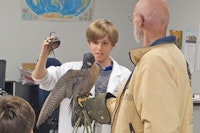Taking it to the Max; FCC in the Schools

Max from Greenville, South Carolina, has been a Falling Creek camper for several years. One of his favorite activities at camp was cooking the “Longenecker Lumps”. When I took a raptor program to Christ Church Episcopal School last year, he all but begged to become my very first “Lump Assistant” (LA) when we cooked them at the end of June Camp.

This school year, Max became a different kind of assistant as he helped me with several fifth grade raptor programs when I visited Christ Church Episcopal School. All together, we taught five classes, then an after-school class for CCES parents and siblings who were curious about what their child learned that day. Max is currently in the sixth grade.
During this past summer, Max was a member of a group at Falling Creek called the Falconers of Falling Creek Camp or FFCC, a six-day program for boys of many different ages, all willing to feed the birds daily, check on them each night and teach others at camp what they’ve learned when they present a program to the other campers on their last day with the birds.
Max had a number of roles as my Assistant Teacher at his school. Perhaps the hardest one for him was explaining to children only one year younger, just WHY he was there and acting as my helper. They had no idea that he had spent an entire week the summer before, learning-about birds of prey!
 Connecting both the sight and sound at the same time is a great way to remember birds that you usually don’t see except in videos. Here is Max at the class’s computer station, taking the place of Mr. Levin, the regular science teacher.
Connecting both the sight and sound at the same time is a great way to remember birds that you usually don’t see except in videos. Here is Max at the class’s computer station, taking the place of Mr. Levin, the regular science teacher.
We wanted the students to hear the vocalizations made by each of the different raptors as they were displayed to the audience. A WiFi link was made between Cornell University’s Bird Lab and the school, with the bird calls running through the school room’s speakers. When a specific sound was required, Max accessed the website and then everyone heard the sound of the bird as it was carried around the classroom.
Another, often under-appreciated role that Max undertook, was taking care of the enclosures that held each of the birds. Untying the leashes, removing the lock, holding the box steady while the bird is removed, then reversing the process when the bird has been shown to the class…

…Six birds for each of six classes, each time seeing to it that all safety precautions were taken for both the birds and the students. That’s a lot of repetition and concentration, all the time being watched by students only one year younger than Max. If I were his classroom teacher and giving him a grade for the day, you can bet it would have been an A plus!
Written by Steve Longenecker